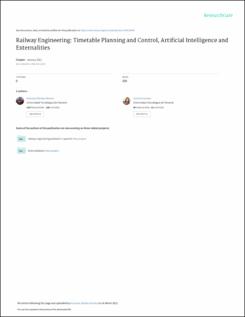| dc.contributor.author | Berbey Alvarez, Aranzazu | |
| dc.contributor.author | Guevara Cedeño, Jessica | |
| dc.date.accessioned | 2021-11-25T18:49:08Z | |
| dc.date.available | 2021-11-25T18:49:08Z | |
| dc.date.issued | 2021-01 | |
| dc.identifier.uri | https://ridda2.utp.ac.pa/handle/123456789/13437 | |
| dc.description | This chapter is a case study of the dissemination of railway engineering research in Latin America developed by a railway engineering research group. The leader of the group is a female researcher. The
authors aim to inspire to other women researchers in Latin American and Caribbean (LAC) countries
who are trying to develop research in IT areas, many times facing serious difficulties, incomprehension,
and great challenges. This chapter is divided in set sections like introduction, background, development
of railway engineering research. This third section is divided into subsections like timetable planning
and trains control, characterization of Panama metro line 1, dwelling times, fuzzy logic, artificial intelligence, social-economics railway externalities, and environmental railway externalities. The fourth
section presents the results of the relationship between research activity and teaching of railway engineering obtained in this case study. Finally, the authors present a brief vision about future and emerging
regional trends about railway engineering projects. | en_US |
| dc.description.abstract | This chapter is a case study of the dissemination of railway engineering research in Latin America developed by a railway engineering research group. The leader of the group is a female researcher. The
authors aim to inspire to other women researchers in Latin American and Caribbean (LAC) countries
who are trying to develop research in IT areas, many times facing serious difficulties, incomprehension,
and great challenges. This chapter is divided in set sections like introduction, background, development
of railway engineering research. This third section is divided into subsections like timetable planning
and trains control, characterization of Panama metro line 1, dwelling times, fuzzy logic, artificial intelligence, social-economics railway externalities, and environmental railway externalities. The fourth
section presents the results of the relationship between research activity and teaching of railway engineering obtained in this case study. Finally, the authors present a brief vision about future and emerging
regional trends about railway engineering projects. | en_US |
| dc.format | application/pdf | en_US |
| dc.language.iso | en_US | en_US |
| dc.rights | info:eu-repo/semantics/openAccess | en_US |
| dc.rights | https://creativecommons.org/licenses/by-nc-sa/4.0 | en_US |
| dc.subject | Railway | en_US |
| dc.subject | Engineering | en_US |
| dc.title | Railway Engineering: Timetable Planning and Control, Artificial Intelligence and Externalities | en_US |
| dc.type | info:eu-repo/semantics/article | en_US |
| dc.type | info:eu-repo/semantics/submittedVersion | en_US |
